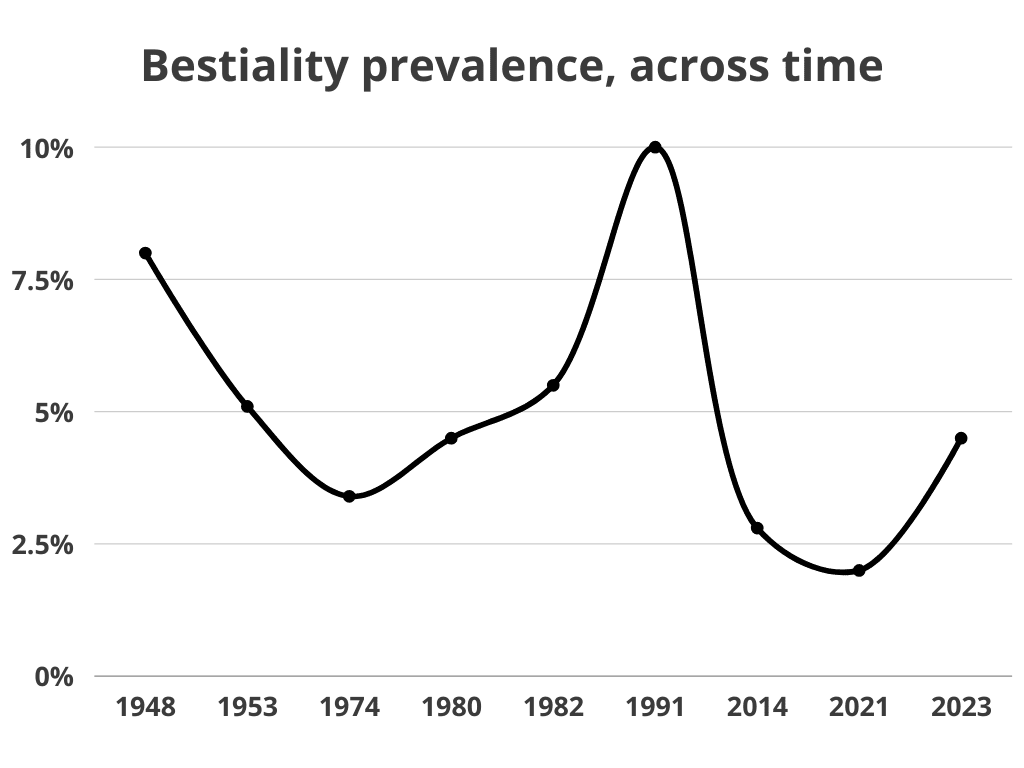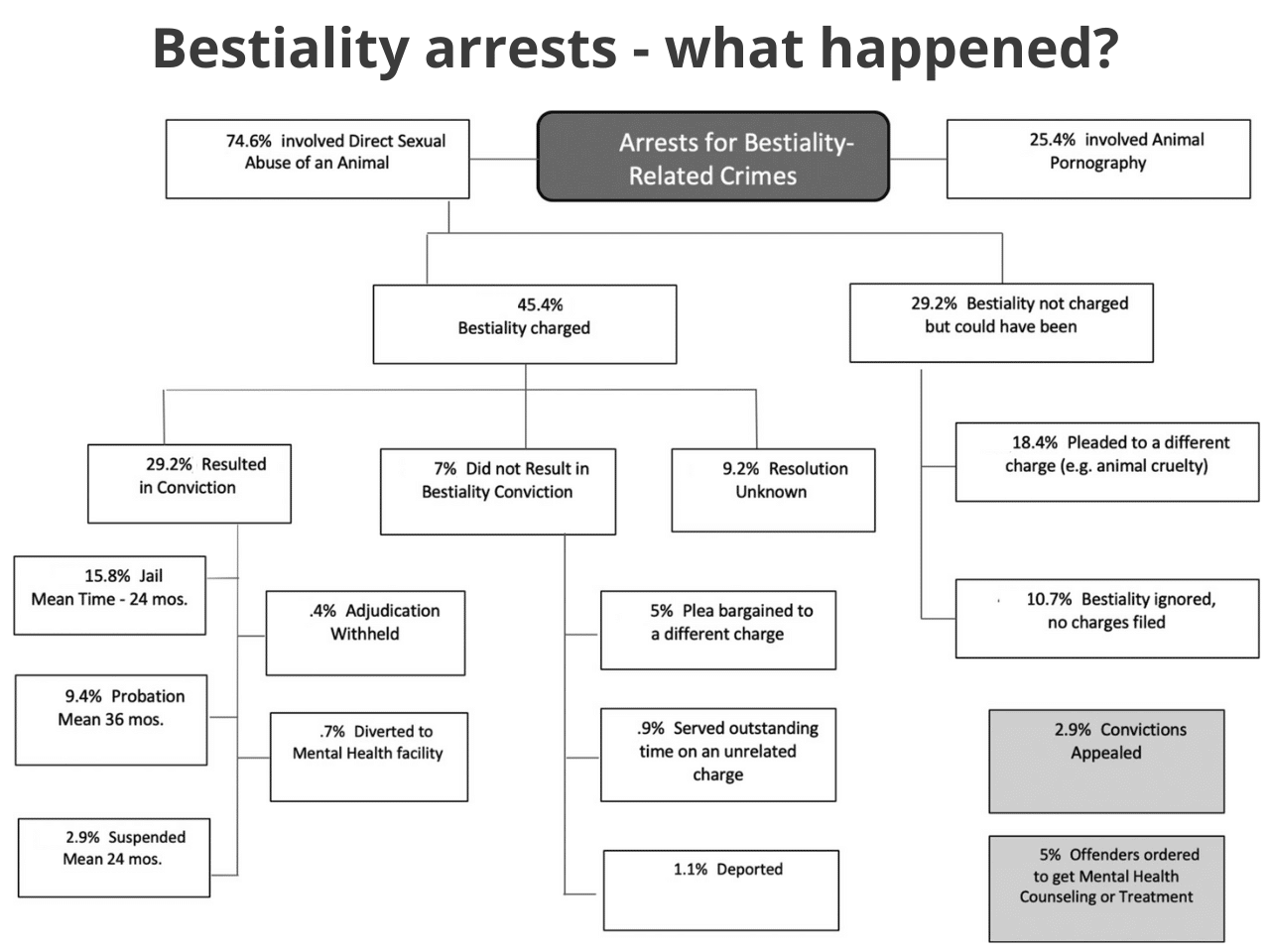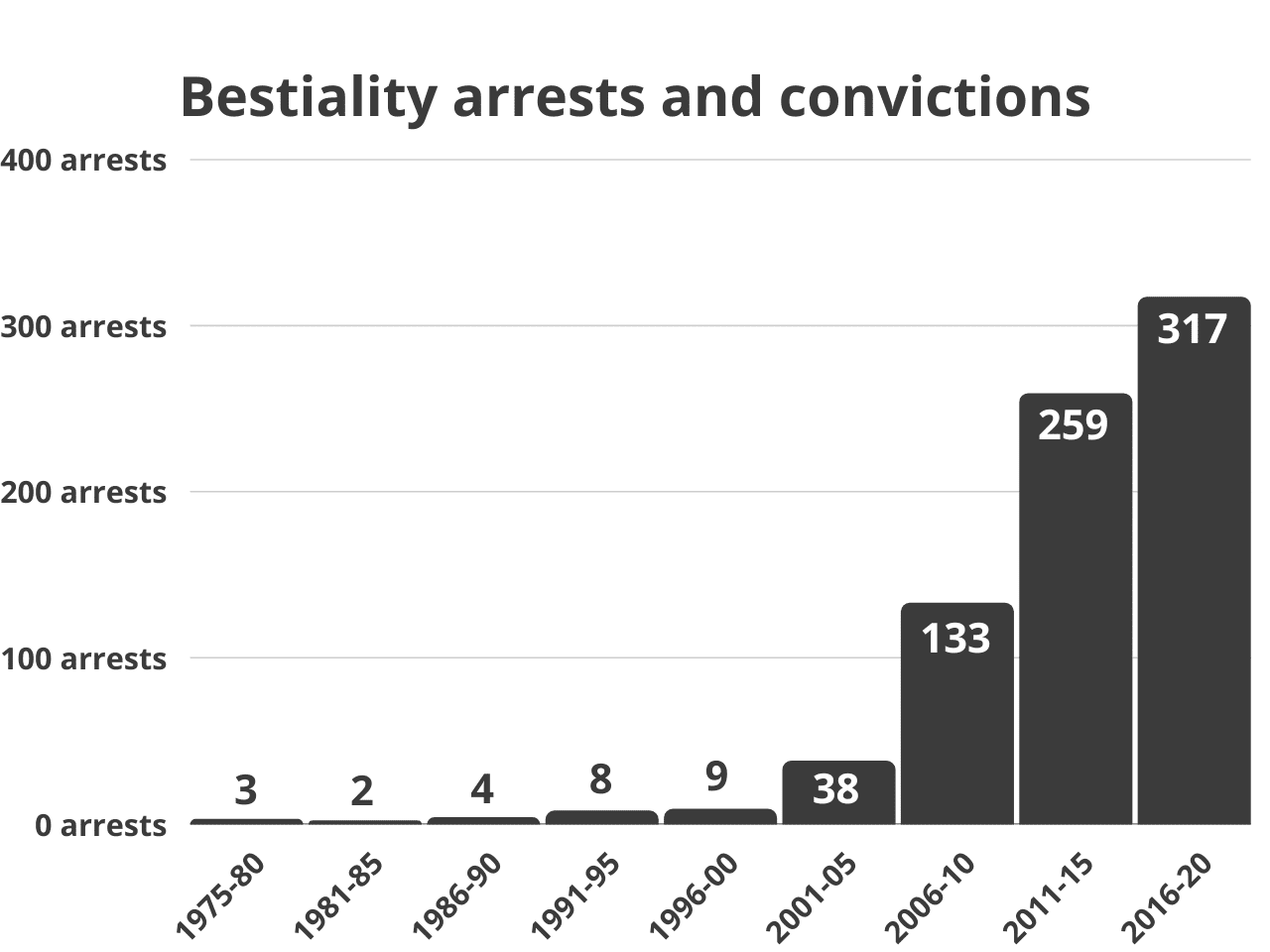![How Common Is Bestiality and Zoophilia [Statistics]](https://wp.bedbible.com/wp-content/uploads/2024/06/How-Common-Is-Bestiality-and-Zoophilia-Statistics.png)
Bestiality and zoophilia, which involve sexual interactions between humans and animals, are sensitive and often misunderstood topics.
This report aims to provide clear and factual insights into these behaviors. We start by defining bestiality and zoophilia, then examine how common they are over time. We also look at US laws, arrest records, and annual trends in bestiality arrests. Additionally, we discuss the types of animals involved, reasons people give for these acts, and the demographics of offenders.
Our goal is to offer a straightforward and comprehensive understanding of these issues.
Here’s what we’ve covered in this article:
- Definition of Bestiality and Zoophilia
- Prevalence of Bestiality Across Time
- US Laws Against Bestiality
- Arrest Records
- Bestiality Arrests Per Year
- The Animals
- What Reasons Do People Provide for Bestiality?
- Bestiality Offenders Demographic Characteristics
- Facts About Bestiality
Key Takeaways
- 4.75% of the population self-reported to have engaged in bestiality at one point.
- 86.0% of bestiality offenders are male (13.6% are female).
- Bestiality arrests have increased by more than 3000% in the last 20 years (1996-2000 vs. 2016-2020).
- Only 39.1% of arrests involving bestiality resulted in prosecution.
- Two US states do not have laws against bestiality (New Mexico, and West Virginia)
- 86% of reported cases of bestiality involved penetration.
- 72.5% of animals were well-known or lived near the convicted.
- 20% reported that they committed bestiality because they did not feel attractive to others.
- +50% of bestiality offenders are between 20 and 50 years of age.
- 85% of bestiality offenders are white, compared to 58% of the general US population.
Definition of Bestiality and Zoophilia
Typically people will think of bestiality and zoophilia as the same thing. However, that is not the case. In the following, I will answer the questions of what bestiality and zoophilia is. I will also explain the main differences between them.
What is Bestiality
Bestiality is sexual activity between a human and a non-human animal. It is also referred to as cross-species sexual activity – which by definition is non-reproductive.
What is Zoophilia
Zoophilia is a type of paraphilia, where humans are sexually attracted to animals. The term was coined by Richard Freiherr von Krafft-Ebing, a German psychiatrist, in his work Psychopathia Sexualis (1886). Whereas he also reported on cases of bestiality.
The difference between Zoophilia and Bestiality
While bestiality is the sexual act with a non-human animal (mammals, birds, reptiles, or amphibians, either dead or alive), Zoophilia on the other hand is simply the sexual desire for such species. Bestiality also has been used predominantly in terms of describing sexual assault and abuse of animals, while zoophiles are used to describe people who form an emotional and sexual bond with animals.
What is it called when humans are attracted to animals? When humans are attracted to animals they have Zoophillia and are called zoophiles.
What is it called when humans have sexual intercourse with animals? When humans have sex with animals it is called Bestiality.
Prevalence of Bestiality Across Time
Based on our meta-study we have provided the best estimates of the prevalence of bestiality in 2023.
- 2-7.5% of the population have engaged in bestiality at one point (sexual encounter with an animal).

In an effort of transparency, the below table lists all the data points with references to the studies, the number of participants in each study.
| Year | Percentage of population | N | Reference |
|---|---|---|---|
| 1948 | 8% men; 40-50% in rural areas | 5,300 men | Kinsey & Pomeroy (1948) |
| 1953 | 5.1% women; 1.5% for pre-adolescents and 3.6% for post-adolescents women | 6,000 women | Kinsey et al. (1953) |
| 1974 | 4.9% men; 1.9% women | 2,026 (982 men; 1,044 women) | Hunt (1974) |
| 1980 | 5.3% men; | 94 men | Crépault & Couture (1980) |
| 1982 | 7.5% | 103 (N/A) | Story (1982) |
| 1991 | 10-15%; 55% among psychiatric patients | 60 (N/A) | Alvarez Freinhar (1991) |
| 2014 | 2.2% men; 3% women | 1,516 (799 men; 717 women) | Joyel et al. (2014) |
| 2021 | 2% | 2,583 (N/A) | Campo-Arias et al. (2021) |
| 2023 estimate: | 2 – 7.5% | 17,682 | Bedbible Institute (2023) |
US Laws Against Bestiality
In the below list, we have listed the US laws against bestiality.
Only 48 US states have laws against bestiality.
Meaning that it is not illegal to have sex with animals in Wyoming, West Virginia, and New Mexico (Hawaii made it illegal in 2021 with the passing of HRS § 711-1109.8).
| State | Law | Felony; The person is guilty of a crime of the fourth-degree | Year of introduction |
|---|---|---|---|
| Alabama | § 13A-6-220 – 221 | Class A misdemeanor | 1975 |
| Alaska | A.S. 11.61.140 | Class A misdemeanor | 1978 |
| Arizona | A.R.S. § 13-1411 | Class 6 felony | 2006 |
| Arkansas | A.C.A. § 5-14-122 | Class A misdemeanor | 1977 |
| California | Cal. Penal Code § 286.5 | Misdemeanor | 1975 |
| Colorado | C. R. S. A. § 18-9-202 | Class 1 misdemeanor | 1977 |
| Connecticut | C. G. S. A. § 53a-73a | Class A misdemeanor | 1975 |
| Delaware | 11 Del.C. § 775 | Class D felony | 1993 |
| Florida | West’s F. S. A. 828.126 | Misdemeanor of the first degree | 2011 |
| Georgia | Ga. Code Ann., § 16-6-6 | Felony: imprisonment for not less than one nor more than five years | 1968 |
| Hawaii | HRS § 711-1109.8 | Misdemeanor for the first offense. Class C felony for the subsequent offenses | 2021 |
| Idaho | I.C. § 18-6605 | Felony (punishable by imprisonment not less than five years) | 1994 |
| Illinois | 720 I.L.C.S. 5/12-35 | Class 4 felony | 1961 |
| Indiana | I.C. 35-46-3-14 | Level 6 felony | 2007 |
| Iowa | I.C.A. § 717C.1 | Aggravated misdemeanor | 2001 |
| Kansas | K.S.A. 21-5504 | class B nonperson misdemeanor | 2010 |
| Kentucky | KRS § 525.137 | Class D Felony | 2019 |
| Louisiana | LSA-R.S. 14:89.3 | Felony, Fine of not more than $2,000, imprisoned, with or without hard labor, for not more than 5 years, or both. | 2018 |
| Maine | 17 M.R.S.A. § 1031 | Class D crime (misdemeanor) | 1987 |
| Maryland | MD Code, Criminal Law, § 3-322 | Misdemeanor, On conviction subject to imprisonment not exceeding 10 years or a fine not exceeding $1,000 or both. | 2002 |
| Massachusetts | M.G.L.A. 272 § 77 | Felony; First offense: imprisonment in the state prison for not more than 7 years or by imprisonment in a jail or house of correction for not more than 2 ½ years, by a fine of not more than $5,000 or by both such fine and imprisonment. | 1978 |
| Michigan | M.C.L.A. 750.158 | Felony, punishable by imprisonment in the state prison not more than 15 years. | 1931 |
| Minnesota | M.S.A. § 609.294 | Misdemeanor | 1987 |
| Mississippi | Miss. Code Ann. § 97-29-59 | Felony (not listed but punishment is imprisonment in the penitentiary for a term of not more than 10 years) | 1930 |
| Missouri | V.A.M.S. 566.111 | Felony | 2002 |
| Montana | MCA 45-8-218 | Class A misdemeanor | 1921 |
| Nebraska | Neb. Rev. St. § 28-1010 | Class III misdemeanor | 1977 |
| Nevada | N. R. S. 201.455 | Felony, a gross misdemeanor | 2017 |
| New Hampshire | N.H. Rev. Stat. § 644:8g | Class A misdemeanor | 2016 |
| New Jersey | N. J. S. A. 4:22-17 | Felony; The person is guilty of a crime of the fourth degree | 1995 |
| New Mexico | N/A | N/A | N/A |
| New York | McKinney’s Penal Law § 130.20 | Class A misdemeanor | 1965 |
| North Carolina | N.C.G.S.A. § 14-177 | Punished as a Class I felon | 2015 |
| North Dakota | NDCC, § 12.1-20-12 | Class A misdemeanor | 1973 |
| Ohio | R.C. § 959.21 | Misdemeanor of the second degree | 2016 |
| Oklahoma | 21 Okl. St. Ann. § 886 | Punishable by imprisonment in the custody of the Department of Corrections not exceeding ten (10) years | 1910 |
| Oregon | O. R. S. § 167.333 | Class A misdemeanor | 2001 |
| Pennsylvania | 18 Pa.C.S.A. § 3129 | Misdemeanor of the second degree | 1999 |
| Rhode Island | Gen.Laws 1956, § 11-10-1 | Felony with imprisonment not exceeding 20 years nor less than 7 years | 1896 |
| South Carolina | Code 1976 § 16-15-120 | Felony with imprisonment in the Penitentiary for five years or shall pay a fine of not less than $500, or both, at the discretion of the court. | 2019 |
| South Dakota | SDCL § 22-22-42 | Class 6 felony | 2003 |
| Tennessee | T. C. A. § 39-14-214 | Class E felony | 2007 |
| Texas | V. T. C. A., Penal Code § 21.09 | Felony of the second degree | 2017 |
| Utah | U.C.A. 1953 § 76-9-301.8 | Class B misdemeanor | 1993 |
| Vermont | 13 V.S.A. § 352 | Misdemeanor; Punishable by a sentence of imprisonment of not more than one year, or a fine of not more than $2,000.00, or both. | 1989 |
| Virginia | Va. Code Ann. § 18.2-361 | Class 6 felony | 1989 |
| Washington | West’s RCWA 16.52.205 | Class C felony | 1994 |
| West Virginia | N/A | N/A | N/A |
| Wisconsin | W.S.A. 944.17 | Class A misdemeanor | 1973 |
| Wyoming | W.S.1977 § 6-4-601 | Misdemeanor punishable by imprisonment for not more than one (1) year, a fine of not more than one thousand dollars ($1,000.00), or both | 1977 |
Arrest Records
We also found some facts about how these laws are upheld:
- Only 39.1% of arrests involving bestiality resulted in prosecution.
- 52.9% of bestiality convicted criminals already had a criminal record or later got subsequent criminal convictions.
- 25.7 – 27.6% of bestiality convictions are against previously convicted criminals of bestiality (repeat offenders).
- In 10.3% of bestiality arrests the offender did not have sex with an animal but rather facilitated, solicited, filmed, or manipulated a third party to do so.
- In 34.4% of arrests, sexual contact between humans and animals could not be proven but pornographic material was found and used as evidence.

Bestiality Arrests Per Year
We also collected data on the number of arrests and convictions of bestiality from 1975 to 2020.
- From 1975 to 1980 three people were arrested for bestiality, which increased to 317 from 2016 to 2020.
- Bestiality arrests have only decreased one time in history from 1975-80 to 1981-85.

The Animals
- 72.5% of animals were well-known or lived close to the convicted.
- 27.5% of animals that are victims of bestiality are the property of others than the offender.
- 7.5% of bestiality offenders also act in violent or sadistic ways against the animal which results in death or euthanasia.
- 1% of bestiality offenders have sex with dead animals.
- 3.5% of bestiality offenders were also convicted of soliciting animals from others.
What Reasons Do People Provide for Bestiality?
- 1% reported that they committed bestiality because they were drunk or high.
- 11% reported that they committed bestiality because other people influenced them.
- 15% reported that they committed bestiality because they lived on a farm.
- 20% reported that they committed bestiality because they did not feel attractive to others.
- 53% reported that they committed bestiality because they found it pleasurable and had a desired affection.
Bestiality Offenders Demographic Characteristics
The data is based on arrested offenders of bestiality in the US, and the below is different demographic tabulations. For each tabulation the distribution of demographic characteristics of bestiality offenders have been compared to those of the general population.
Age and gender
A tabulation of age compared to the percentage distribution in the normal US population. This tabulation is done for both men and women.
| Age group | Male, % of all bestiality offenders | Male, % of US population |
|---|---|---|
| < 20 | 0.8% | 26.3% |
| 20–29 | 27.2% | 14.0% |
| 30–39 | 22.8% | 14.4% |
| 40–49 | 22.6% | 12.8% |
| 51–60 | 19.0% | 13.2% |
| 61–70 | 6.6% | 12.0% |
| 71–80 | 1.1% | 7.3% |
And for women bestiality offenders the distribution on age looks like the following:
| Age group | Female, % of all bestiality offenders | Female, % of US population |
|---|---|---|
| < 20 | 3.3% | 25.1% |
| 20–29 | 35.0% | 13.5% |
| 30–39 | 28.3% | 14.0% |
| 40–49 | 25.0% | 12.8% |
| 51–60 | 6.7% | 13.4% |
| 61–70 | 1.7% | 12.8% |
| 71–80 | 0.0% | 8.5% |
What is not apparent from the above tabulation is the distribution between male and female bestiality offenders:
- 86.0% of bestiality offenders are male.
- 13.6% of bestiality offenders are female.
- 0.4% of bestiality offenders identify as transgender or were not willing to disclose their gender.
Ethnicity
What the data clearly shows is that the far majority of bestiality offenders are white.
- 84.9% of bestiality offenders are white.
| Race | % of all bestiality offenders | % of population |
|---|---|---|
| White | 84.9% | 57.8% |
| African American | 6.5% | 12.1% |
| Hispanic | 6.3% | 18.7% |
| Other | 2.3% | 11.4% |
Relationship status
Relationship status is highly correlated with age and gender. This means that the bestiality offender group is not comparable to the general US population on relationship status as they differ on significant variables already. Therefore it does not make sense to compare the groups characteristics on relationship status to that of the general US population.
| Relationship status | % of offenders |
|---|---|
| Single, no intimate relationships with humans | 12.5% |
| Is or has been in an intimate human relationship | 87.5% |
Employment
In some respects employment groups can also not be compared directly to that of the US population. However, this is also due to the lack of opportunity to classify certain professions without asking respondents directly.
| Employment, proffession: | % of bestiality offenders |
|---|---|
| Animal-related | 14.2% |
| Child-related | 4.1% |
| Student, unemployed | 8.9% |
| Military, fire, law enforcement | 14.8% |
| Teacher, minister | 6.5% |
| Medical, legal | 8.9% |
| Employed, not otherwise specified | 42.6% |
Facts About Bestiality
- Studies have shown that people who engage in bestiality may have a higher risk of developing certain mental health problems, such as anxiety and depression.
- Bestiality is often associated with other illegal activities such as animal abuse, child pornography, and sexual assault.
- Bestiality has been linked to the spread of certain zoonotic diseases, such as brucellosis and rabies, which can be transmitted from animals to humans. According to the Centers for Disease Control and Prevention, there have been several cases of humans contracting brucellosis from infected animals used in bestiality.
- Studies have shown that people who engage in bestiality may have a higher risk of developing certain mental health problems, such as anxiety and depression. A study published in the Journal of Sex Research found that individuals who engaged in bestiality were more likely to have a history of childhood sexual abuse and to report symptoms of post-traumatic stress disorder (PTSD).
- A study published in the Journal of Sex Research found that individuals who engaged in bestiality were more likely to have other paraphilias, such as exhibitionism and voyeurism.
